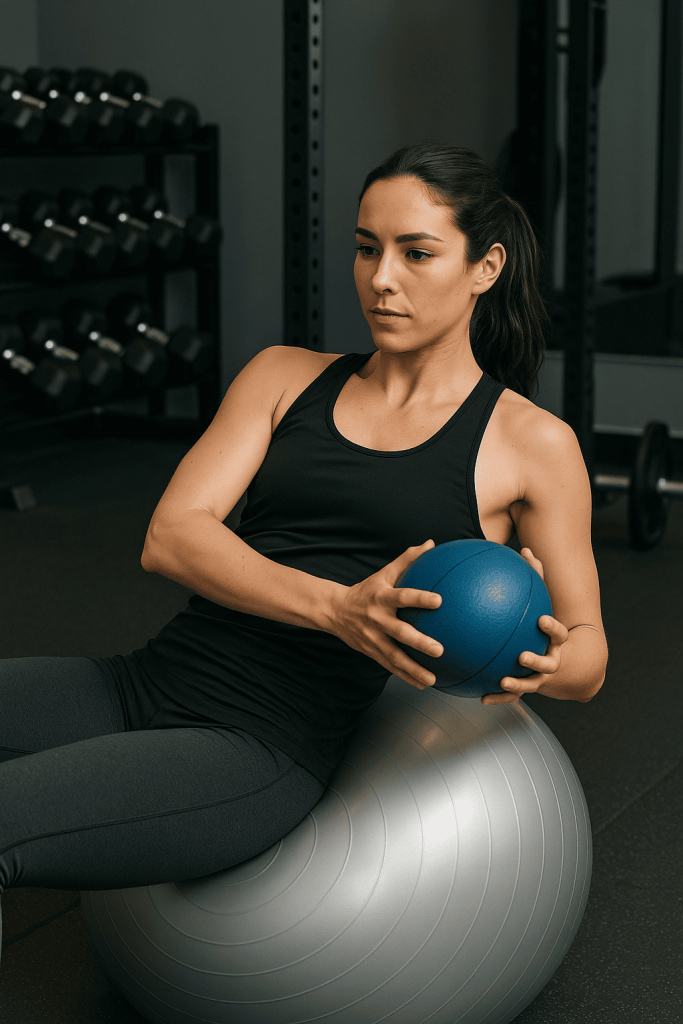5 de May de 2025
Russian Twist on Swiss Ball: Exercise Guide, Tips and Benefits
The Russian twist on a Swiss ball is a dynamic core-strengthening exercise that enhances rotational stability, balance, and postural control. By performing this movement on an unstable surface, you activate deeper stabilizer muscles and elevate the challenge for your entire core. It’s a smart addition for athletes, clients in rehab, or anyone aiming to improve trunk control and movement quality.
What Are Russian Twists on a Swiss Ball?
Russian twists on a Swiss ball involve reclining on the ball in a bridge-like position and rotating the torso side to side, typically while holding a weight. The ball creates instability, which forces your core and hip stabilizers to work harder to maintain alignment. Unlike floor-based twists, the Swiss ball version adds an element of instability that targets balance and coordination in addition to strength.

How to Do Russian Twists on a Swiss Ball Properly
- Sit on the Swiss ball and walk your feet forward until your shoulders rest on the ball and your hips form a straight line with your knees.
- Hold a medicine ball or light weight with both hands at chest level, arms slightly extended.
- Engage your core and rotate your torso to one side, keeping your hips and legs stable.
- Return to the center, then twist to the opposite side.
- Complete 2–3 sets of 10–15 reps per side with control and rhythm.
Tip: Keep your hips elevated and glutes tight throughout the movement. Avoid using momentum to swing the arms.
Muscles Worked by Russian Twists on a Swiss Ball
This exercise primarily targets the core and spinal stabilizers:
- Obliques: Drive the rotational movement.
- Transverse abdominis: Stabilizes the torso and prevents excessive motion.
- Rectus abdominis: Helps control movement and trunk flexion.
- Erector spinae: Keeps the spine aligned on the unstable surface.
- Glutes and hamstrings: Support the bridge position on the ball.
Benefits of Russian Twists on a Swiss Ball
- Improved Rotational Strength and Control: Enhances performance in sports and daily activities that involve twisting.
- Increased Core Stability: Engages deeper abdominal muscles that protect the spine.
- Better Balance and Coordination: The unstable surface demands full-body control.
- Postural Reinforcement: Promotes proper alignment and control under dynamic tension.
- Low-Impact Yet Challenging: Great for conditioning without adding joint stress.
Common Mistakes to Avoid
- Dropping the Hips: Keep your body in a stable bridge position.
- Over-Rotating the Lower Back: Focus on thoracic rotation and avoid lumbar twisting.
- Using Only Arms: Engage your entire core—not just swinging the weight side to side.
- Holding Breath: Breathe rhythmically to stay relaxed and maintain muscle control.

Variations of Russian Twists on a Swiss Ball
- Bodyweight Twist: No added load—great for beginners.
- Weighted Twist: Hold a dumbbell or medicine ball to increase resistance.
- Slow-Tempo Twists: Pause at each end of the rotation to improve time under tension.
- Band-Resisted Twist: Anchor a band to one side for progressive resistance.
How to Include Russian Twists on a Swiss Ball in Your S&C Workout
This exercise fits perfectly in core circuits, warm-ups, or cooldowns focused on trunk control. Perform 2–3 sets of 10–15 reps per side, 1–2 times per week. It pairs well with anti-rotation drills or postural work. During high-load training phases, it can also help reduce fatigue while maintaining core engagement and movement quality.
FAQs About Russian Twists on a Swiss Ball
What are the benefits of Russian twist on ball?
It improves oblique strength, balance, rotational control, and spinal stability through a more dynamic, functional range of motion.
What are the disadvantages of Russian twist?
When done incorrectly, it can stress the lower back—especially with heavy weights or poor rotation mechanics.
Are Russian twists good for basketball?
Yes, they enhance core stability and rotational control, which are crucial for passing, shooting, and lateral movement on the court.
What not to do when doing Russian twists?
Avoid twisting from the lower back, letting your hips drop, or rushing through the movement. Controlled, quality rotation is key.
The Russian twist on a Swiss ball is a powerful and versatile core exercise that helps reinforce movement control, improve balance, and reduce risk of injury. When integrated into a smart strength and conditioning plan, it supports foundational stability and mitigates fatigue without overloading the body.
